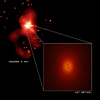Trail of Black Holes and Neutron Stars Points to Ancient Collision
The Chandra image of the elliptical galaxy NGC 4261 reveals dozens of black holes and neutron stars strung out across tens of thousands of light years like beads on a necklace. The spectacular structure, which is not apparent from the optical image of the galaxy, is thought to be the remains of a collision between galaxies a few billion years ago.
According to this interpretation, a smaller galaxy was captured and pulled apart by the gravitational tidal forces of NGC 4261. As the doomed galaxy fell into the larger galaxy, large streams of gas were pulled out into long tidal tails. Shock waves in these tidal tails triggered the formation of many massive stars.
Over the course of a few million years, these stars evolved into neutron stars or black holes. A few of these collapsed stars had companion stars, and became bright X-ray sources as gas from the companions was captured by their intense gravitational fields.
The currently favored view is that elliptical galaxies are produced by collisions between spiral galaxies. Computer simulations of galaxy collisions support this idea, and optical evidence of tails, shells, ripples, arcs and other structures have been interpreted as evidence for this theory.
However as the image shows, the optical evidence rather quickly fades into the starry background of the galaxy, whereas the X-ray signature lingers for hundreds of millions of years. Chandra's image of NGC 4261 shows that X-ray observations may be the best way to identify the ancient remains of mergers between galaxies.
|
||||||||||||||||||||||||||||
A two panel graphic shows a Chandra X-ray Observatory image (left) and a ground-based optical image (right) of an elliptical galaxy, NGC 4261. The galaxy is colored orange in X-ray and yellow in optical. The shape of the galaxy resembles an oval in the optical, but is clumpy and quite irregular in X-ray. This type of galaxy is characterized by its large size, low levels of star formation, and a lack of well-defined spiral arms like those found in spiral galaxies such as the Milky Way. The X-ray image of NGC 4261 highlights various structures within the galaxy, including its central region, halo, and outskirts. The central part of the galaxy has a more concentrated distribution of X-ray emission, while the outer regions exhibit lower levels of X-ray brightness. The halo surrounding the galaxy is also visible in the X-ray image, appearing as a faint, diffuse glow. The Chandra image of NGC 4261 reveals dozens of black holes and neutron stars strung out across tens of thousands of light years like beads on a necklace. The spectacular structure, which is not apparent from the optical image of the galaxy, is thought to be the remains of a collision between galaxies a few billion years ago.





